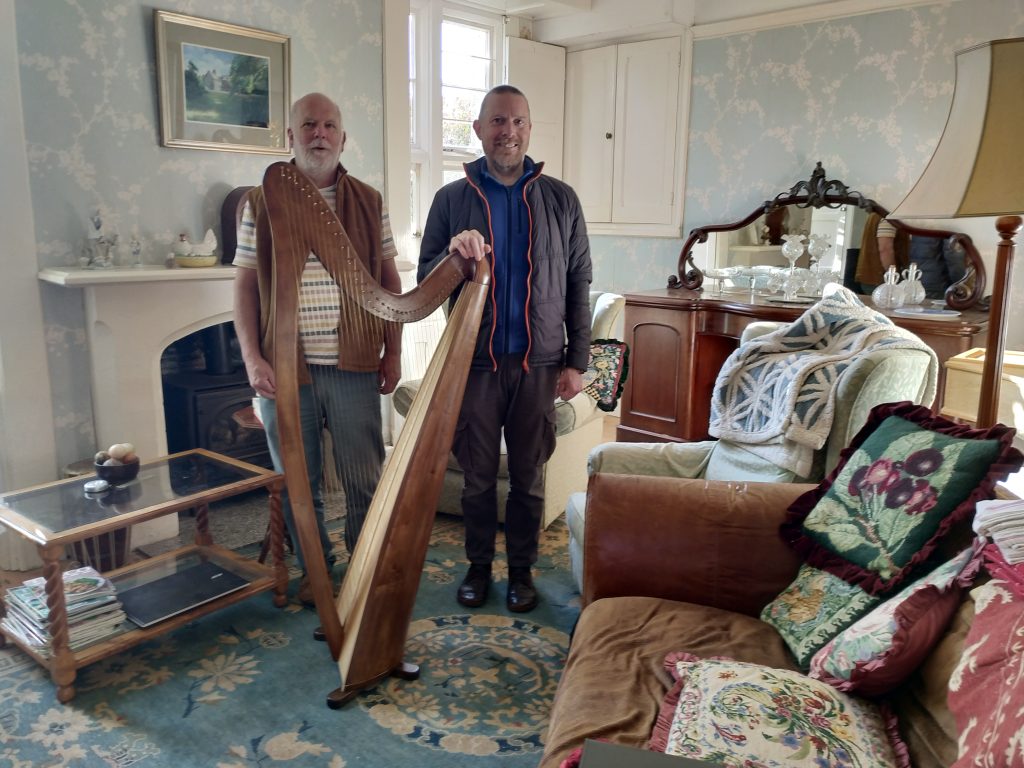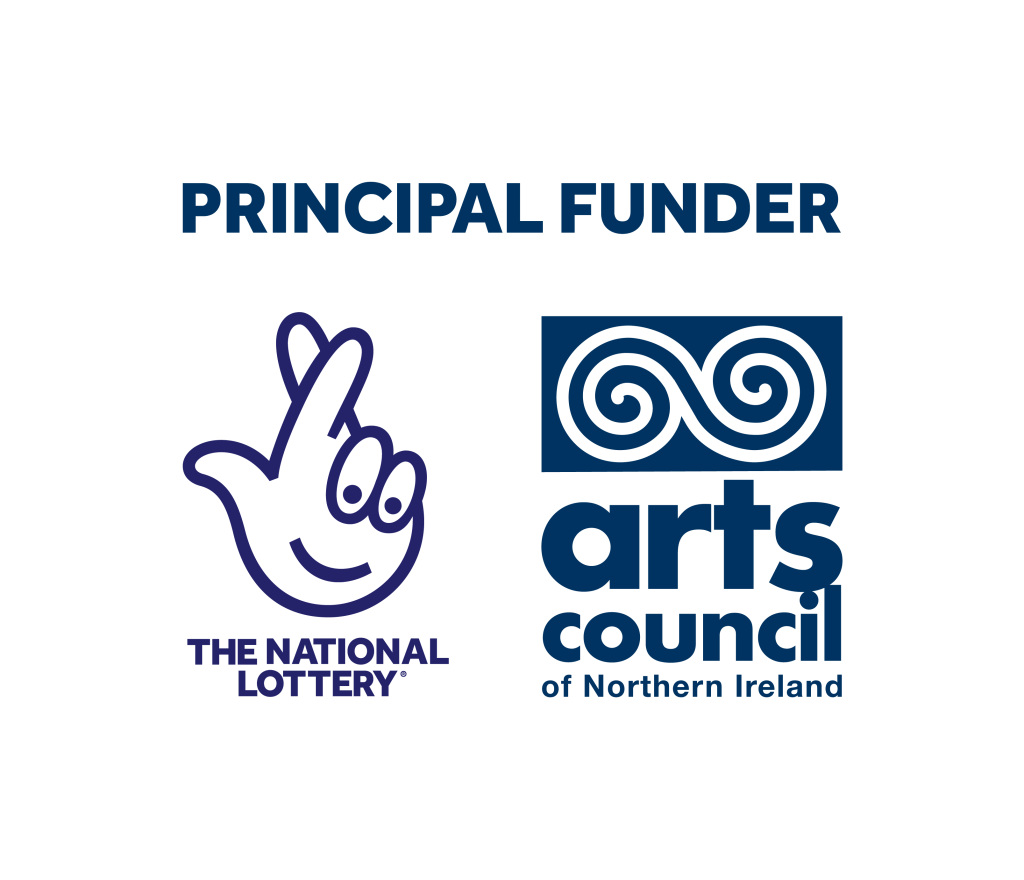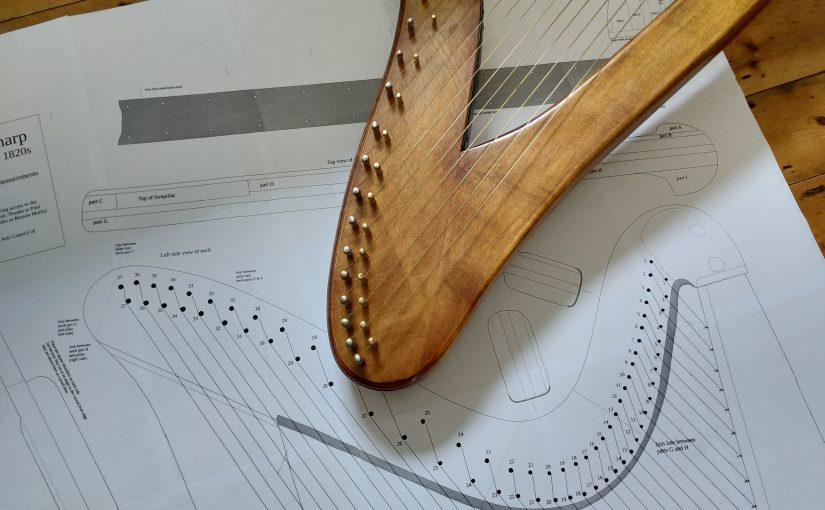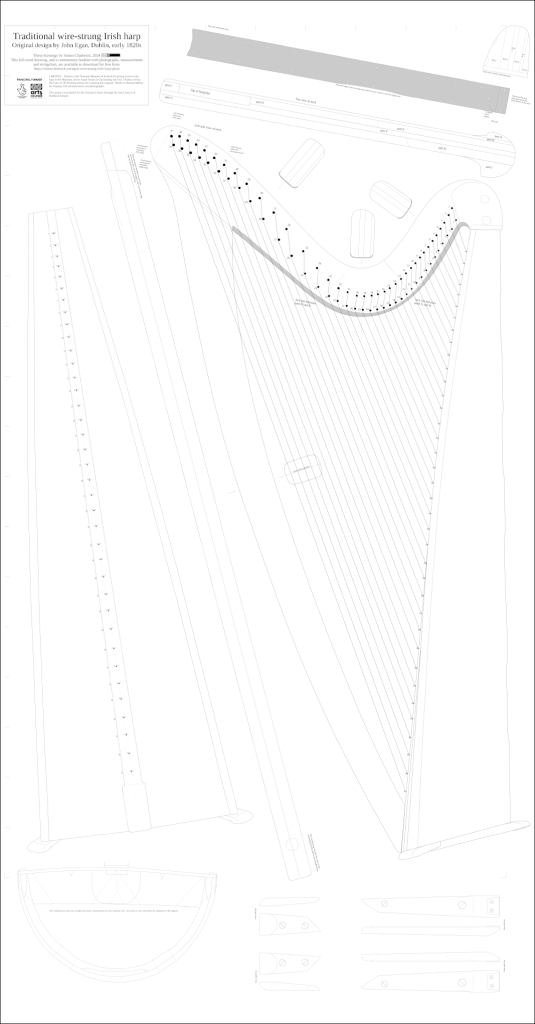One of my recent projects has been to create a set of harpmakers’ plans and templates for making a 19th century style traditional wire-strung Irish harp.
About this model of harp
In the 1820s, the Belfast Harp School (organised and bankrolled by the Irish Harp Society) was training a whole new generation of traditional Irish harpers. These harpers were learning the traditional method of playing the wire-strung Irish harp, studying with teachers who themselves had learned in the inherited tradition back generations.
The Irish Harp Society purchased harps, not only for use in the School, but also to give each of the pupils a harp when they had finished their studies, so that each of the harpers could leave the school, and go out to make a living as a professional traditional Irish harper.
From about 1820, the Irish Harp Society ordered its harps from the Dublin harpmaker John Egan. The Egan firm made all kinds of harps, from full size pedal harps to heraldic and decorative novelties. However, for the Irish Harp Society, Egan designed this model of traditional wire-strung harp specifically for the teachers and pupils working in the inherited Irish harp tradition. The Egan wire-strung harps have many unique design features that seem specifically intended to make these instruments suitable for Irish harpers working in the inherited tradition. The Egan wire-strung harps were intended to work the same as the older designs of traditional wire-strung Irish harps, but louder, more powerful, more ergonomic, and cheaper and easier to produce.
When I first started my Long 19th Century research project, I did not really know what these 19th century traditional wire-strung Irish harps were like, or how they would work; many previous Irish harp scholars had been pretty dismissive of them.

In 2022 I asked Tim Hampson make me a copy of one of the John Egan wire-strung harps, as a “proof of concept” prototype to see if the design was any use. The harp was made for me at the beginning of 2023, and it was so successful and worked so well that I have no hesitation in recommending this John Egan wire-strung Irish harp design to anyone interested in playing the traditional wire-strung Irish harp and working within the parameters of the inherited tradition, using the fingering techniques and method of playing of the old harpers. That is the reason why I wanted to produce accurate and freely-available drawings and templates of John Egan’s design, so that other harpmakers can produce more of this model of harp.
The harp my templates are based on

My plans are derived from a 3D scan of John Egan harp no.1933 which was made in the early 1820s for the Irish Harp Society. I suspect that this particular harp may have been used as a classroom harp at the Harp School in Cromac Street. It has less decoration than the other Egan wire-strung harps that survive, and it has an inscription stating that it was made for the Society.
The teachers of the school in the 1820s and 1830s were Edward McBride, Valentine Rennie, and Alexander Jackson; Many of their pupils may have played on this school harp as part of their training, including Patrick Byrne, Thomas Hanna, and Hugh Frazer.
By the early 1900s, this harp was owned by Robert Bruce Armstrong, and is shown in the frontispiece to his 1904 book. He gave it to the National Museum of Ireland where it remains today, with the registration number NMI DF:1913.381
Gathering the data
The harp was scanned in situ in the Museum by Paul McCann of 3D Printing Ireland. The data capture took about 2 1/2 hours; I also spent a couple of hours taking hand measurements of parts that I thought the scan would not show well – the soundboard thickness and tuning pin sizes.
The various different takes from the two different scanners were combined to create a 3D model:
Egan Irish harp (National Museum of Ireland) by Simon Chadwick on Sketchfab
Drawings
The 3D model is an amazingly powerful way to understand the form and structure of the harp, but it can take a lot of technical skill to manipulate the model on-screen and to extract useful profiles, sections and templates from it. So as part of the project, I did that work. I made accurate orthogonal renderings of the different components of the harp separately, and then I traced over the renderings to create a set of technical drawings.
I made the drawings on one single sheet, showing the entire harp full-sized.
Because the scan only captured the visible external surfaces of the harp, it does not include the interior of the hollow soundbox. In a couple of previous scans I have done, the scanner was able to image fragments of the interior surfaces. Due to problems with the scanning at the Museum, we only managed to capture a small amount of interior surfaces towards the bass end of the soundbox, and these fragments were not included in the finished 3D model. But I could nonetheless use them as part of my drawings.
Another issue with the interior structures is that the way these harps are constructed, they are built from the outside in, with the internal ribs and braces and other structural parts fitted into the outer shell. So I thought that measurements and photographs would be more useful to harpmakers than trying to do technical drawings of those internal structures. My measurements and photographs are in a separate 22 page booklet that accompanies the full-sized drawing.
Getting a copy
The drawings are available to download for free. They are issued under an open license which means that they are free to download, use, re-use, adapt and distribute however you like without asking any further permissions.
I have put the files on their own page: Egan wire-strung Irish harp plans. That page explains how to download and print out the plans and gives more information about them.
What next?
I am now planning to have some sets of tuning pins made for this design of harp, which I hope to be able to offer for sale in my shop. I can also supply the wire needed for stringing the harp.
I hope that harpmakers will be inspired to make harps based on these drawings, and I hope that harpers who are studying the traditional Irish harp fingering techniques and method of playing the wire-strung harp will take these plans to their local harpmaker, and ask to have one made.
I would also like to repeat the project with some of the other 19th century traditional wire-strung Irish harps. I would especially like to scan Paul Smith’s harp, to make a similar set of drawings for Francis Hewson’s 1840s design of traditional wire-strung Irish harp. All we need is for someone to step up and fund the project and we can get going. Let me know!
Credits
Thanks to the National Museum of Ireland for giving access to the harp in the Museum, and to Sarah Nolan for facilitating the visit. Thanks to Paul McCann of 3D Printing Ireland for scanning the original. Thanks to Brenda Malloy for helping with measurements and photography.

The scans and the drawings were funded by the National Lottery through the Arts Council of Northern Ireland.


What an amazing project, and what an effort you have made!
Hopefully people will forward this project unto all the harp websites and facebook pages to let everyone know!
Very interesting, a beautiful harp and for many people this model will be easier to play than the early smaller models.
All the very best wishes for this, looking forward to the Paul Smith harp project.
Excellent! Super work, and thank you for sharing.
I cannot believe how high up on the harmonic curve the pins were placed in the bass!